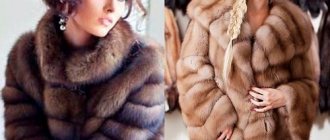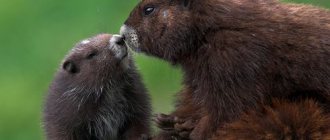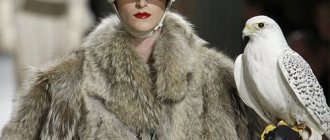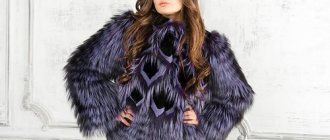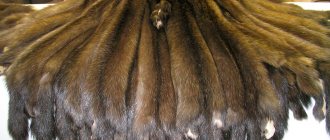It is hardly possible to find at least one woman who would not dream of a warm fur coat. And it is very good if the fur of such an animal as sable is used to sew it. But not everyone is well versed in what it is and what the difference is between sable fur and marten fur. These animals are very similar to each other, as they belong to the mustelidae family. But still there are certain differences between them.
The photo shows sable fur and marten fur
History of appearance and use
Since ancient times, sable fur has been worth its weight in gold. During the times of Kievan Rus, clothes were made from this precious material for princes and local nobility. Even the skins themselves were very valuable.
This material gained its greatest popularity during the Second World War. The fashion for sable products originated in Hollywood. Here its luxury, beauty and quality were received with a bang. Over time, the popularity and value of the valuable animal’s fur did not decrease, but only grew. This has led to the appearance of counterfeits on the markets. Marten fur is considered similar to sable fur. It is this that has become most often used by unscrupulous manufacturers and sellers.
Until the 20th century, sable skins were used only in their natural form, without subjecting them to special processing and finishing. However, in 1996, the famous designer Marc Jacobs proposed a new use of this material. He trimmed his fur. This event became the impetus for changing fashion trends and trends. Today, this fur is very popular not only among fashionistas and lovers of warm luxury, but also among fashion designers who even use it as a decorative element on their outfits.
Fur qualities
Sable fur has many excellent qualities, making it the most popular among manufacturers and buyers.
1. Exclusivity. Sable fur coats are produced only by Russian factories.
2. Practicality and durability. This type of fur is famous for its wearability. A sable fur coat can last faithfully for more than 10 years. Any damage and defects can be easily eliminated or restored.
3. Flawless color. The fur of this animal has a very rich and delicate brown color. It is uniform, so it does not require painting. For these reasons, it is not subjected to further processing.
4. Many types. There are several types of fur depending on the region of production. Each of them is famous for its unique qualities.
5. The ability to use the material for the production of various products. Hats, coats and accessories are sewn from sable skins; outfits are trimmed with it, and the fur is used to make both men's and women's products.
Where are certain varieties used?
The Russian type is used for outerwear in the form of fur coats, trimming the collars of coats made of arctic fox fur, and also for making hats.
Since this variety is closest to natural skins, products made from them can withstand up to 15 seasons - this is for blue color, and up to 10 seasons - white arctic fox fur can withstand.
The Baltic type, however, like the Russian, as well as the Norwegian types, are the favorite materials of designers so that the natural, external luxury of the Arctic fox receives in designer products, to put it in the slang of fashion designers, absolutely unexpected, as well as original visualization.
Arctic fox fur products: fur coat, vest, hat
Varieties of sable
There are several varieties of the famous animal. The Russian sable lives in Siberia. This valuable animal belongs to the mustelidae family. All representatives of this family are popular among breeders and manufacturers of fur products, but the sable is the most valuable.
The other and closest member of the mustelid family is the Canadian or American sable. However, this name is used only by manufacturers of fur products; in biology it has a different definition - marten. Despite the abundance of problems and questions in connection with the belonging of animals to one species or another, no changes were made to their classification. For this reason, buyers of expensive products have to be doubly attentive and picky when purchasing, so as not to fall for the bait of unscrupulous sellers.
Types of sable fur and its value
The most valuable among the entire family of mustelids is the fur of the Barguzin sable. No wonder. After all, the quality of products made from such skins with skillful dressing cannot be compared with anything. The color of the fur is quite dark, covered with sparse silvery hairs. This feature gives it gloss and shine.
The next most valuable is the Yenisei sable. It has a light color - from caramel to beige. Silver hair is already visible much less. The third place is occupied by the Canadian or American sable. The quality of such fur, compared to its competitors, is not so high.
How to distinguish sable fur from marten fur?
Marten fur has long been the main competitor and main material for counterfeit sable fur. For the average buyer, the task of distinguishing one skin from another sometimes becomes insoluble. So, what is the difference between marten fur and sable fur? We will judge according to the following criteria.
1. Color. Sable fur has an even dark brown color with a bluish undercoat. It is very rare to find an animal with light fur. The marten's fur, on the contrary, has spots of light and yellow tint, and the animal has a light mark on its neck.
1. Density. Valuable sable fur (photo shown above) is very thick and soft to the touch. The marten has coarser and less lush vegetation.
2. Wearability. Sable fur coats are famous for their practicality and long service life (up to 12-15 years). Delicate and durable sable leather does not lose its excellent properties for a long time. If necessary, any fur product can be easily restored. The marten does not have such characteristics. Fur coats lose their appearance after 5-7 seasons.
3. Price. Sable fur coats are significantly more expensive than marten products.
What is a marten
This is the name of a medium-sized animal with an elongated body and a length approximately the same as that of a sable. The tail can be half the length of the body. It has small clawed feet. On the sharp muzzle there are triangular small ears bordered with a yellow stripe. It has sharp fangs, which can cause serious damage to an animal or a person who approaches its hole. Shows ferocity when protecting its young.
Marten
There are several types of martens. These are very developed and active animals. Their growing offspring spend almost all their time playing, making sounds reminiscent of cooing. In addition to rodents and birds, they love bird eggs. With a bite to the back of the head, it destroys chickens from which it drinks blood. Can eat snakes, frogs and insects. In autumn, it enriches its diet with berries, nuts and fruits. At this time, she makes provisions for the winter.
Marten on the grass
It is found mainly in European and western Asian mixed and deciduous forests. Can live in mountains where there are trees. Pine martens are excellent climbers and make four-meter jumps . Just like the sable, the marten settles on its territory in hollows or in the nests of birds of prey. They mark their territory with a special secret and protect it.
The marten has become rare in many places. This is due to intensive hunting for it and a reduction in its habitat. One of the problems is the destruction or economic development of forests where these animals live. It does not take root well in captivity, so it can only be seen in certain European zoos.
How to distinguish sable fur?
To avoid getting into trouble in a store, you need to know how to recognize a real sable fur coat. There are several ways:
1. Touch and inspect the product carefully. The use of coloring compounds to create a darker shade is often misleading; moreover, a light color can easily be passed off to an inexperienced buyer as a rare sable. In addition, sable fur is very dense and soft, its hair is long and shiny. The marten cannot boast of such qualities of fur. Its guard hairs are stiffer and more prickly.
2. Swipe against hair growth with your hand. They should be soft and long, easily and quickly take their original shape and fall into place. Only in this case can we talk about the high quality of the product.
3. Pay attention to the quality of the skin. Wrinkle the product a little. If you hear a slight rustling, then the fur coat will not serve you for the promised 10-15 years. Tears may develop in these areas over time. The base of a good fur coat should be soft and elastic.
4. For another test you will need a water bottle. Wet your palm and rub it a little over the product. The sensation should be pleasant and soft, and there should be no hair left on the hand. Examine how tightly and well the hairs adhere to the skin of the product. If you find that the pile is stiff and there is an abundance of hairs on the palm of your hand, it is better to take a closer look at another option.
5. Price. Sable fur coats a priori cannot be cheap.
How to choose a fur product
Sable and marten fur is used for sewing women's and men's outerwear, hats, collars, and decorative elements, especially in designer models.
When buying such things, you need to know what to look for and how to distinguish a fake:
- The first thing you need to pay attention to is the mezdra. The buyer has every right to ask the seller to slightly tear off the lining to see the back of the skin. It should be elastic, easily bendable, light in color and not rustle on the fabric.
- Check the elasticity of the hairs. In good fur, after pressure they quickly return to their original shape.
- Run your hand against the growth of the hairs - they should immediately fall into place without breaks or hesitations. If this does not happen, the fur may be damaged. Also, hairs should not fall out and remain on the palm.
- Inspect for rust. Sables and minks are often kept in cages, and the rods leave marks on the skins that cannot be washed off.
- Check the country of origin. Clothes made from sable are made exclusively in Russia.
- Lightness of even large products. Judging by the reviews, the weight of a mink or marten coat is practically unnoticeable.
- A durable product is distinguished by the number of seams - the fewer there are, the higher the wearability of the item.
Where to buy: review of stores and prices
The shops: Addresses: Website: Prices from (RUB): The shops: Addresses: Website: Prices from (RUB): MechGrad Moscow, Kolpachny lane, 9c1 Ekaterinburg, st. Kuibysheva, 44 St. Petersburg, Suvorovsky prospect no. 18 https://www.mehgrad.ru 240 000 Northern Fox Moscow, Institutsky lane, 12 https://severnylis.rf 200 000 My Fur Moscow, st. Dokukina, 12 https://moimeh.ru 230 000 FurMond Moscow, Baumanskaya street, building 7, building 1 https://furmonde.ru 165 000 KingSobol Moscow, Marshal Zhukov Avenue, 59 https://kingsobol.ru 160 000 Triumph Moscow, Prospekt Mira, 105, building 1 https://www.evro-mexa.ru 200 000 Camphor Moscow, st. Dokukina, 10, building 10 https://kamfur.ru 149 000 Fur Lux Market Gardener https://mexa-lux.ru 148 000 Kalyaev official site https://www.fursk.ru 149 000 World of Furs Moscow, Dokukina st., 10 https://www.mir-shub.ru 120 000 Emil Shabaev Moscow, st. 1812, no. 2 https://emilshabaev.ru 350 000 Elena Furs official site https://elenafurs.ru 261 000 Lapland Moscow, metro station Alekseevskaya https://l-norka.ru 170 000 Addresses
Sable and marten products are a valuable acquisition and a luxurious gift for yourself or loved ones. Such things are distinguished by an abundance of colors, beauty, durability and uniqueness.
Features and disadvantages of marten fur
The marten has obvious shortcomings that can be detected upon examination. Among them, experts especially highlight the ability of such fur to crumble and prick at the seams. It is here that the transition from one skin to another will be more noticeable. For this reason, manufacturers often try to hide this feature by using leather and other inserts. Another way to hide transitions is to use a certain style (with a wide armhole). On the one hand, this adds zest to the product, and on the other hand, it hides its shortcomings.
Skinning a marten
The marten skin is removed using a tube with an incision along the rump. The fur on the head, paws and tail is preserved. The skins are degreased and cleaned of dirt and traces of blood, cuts of meat remains and veins, cartilage from the ears, small bones from the paws and vertebrae in the tail. They are straightened according to the shape with the fur facing out according to the rules. Preservation is carried out using the fresh-dry method.


